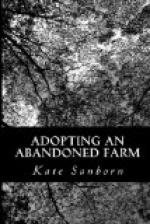A country auction is not so exciting as one in the city; still you must be wide-awake and cool, or you will be fleeced. An experienced friend, acquainted with the auctioneer, piloted me through my first sale, and for ten dollars I bought enough really valuable furniture to fill a large express wagon—as a large desk with drawers, little and big, fascinating pigeon holes, and a secret drawer, for two dollars; queer old table, ten cents; good solid chairs, nine cents each; mahogany center-table, one dollar and sixteen cents; and, best of all, a tall and venerable clock for the landing, only eight dollars! Its “innards” sadly demoralized, but capable of resuscitation, the weights being tin-cans filled with sand and attached by strong twine to the “works.” It has to be wound twice daily, and when the hour hand points to six and the other to ten, I guess that it is about quarter past two, and in five minutes I hear the senile timepiece strike eleven!
The scene was unique. The sale had been advertised in post-office and stores as beginning at 10 A.M., but at eleven the farmers and their women folks were driving toward the house. A dozen old men, chewing tobacco and looking wise, were in the barn yard examining the stock to be sold, the carts and farming tools; a flock of hens were also to be disposed of, at forty cents each.
On such occasions the families from far and near who want to dispose of any old truck are allowed to bring it to add to the motley display. The really valuable possessions, if any, are kept back, either for private sale or to be divided among the heirs. I saw genuine antiques occasionally—old oak chests, finely carved oaken chairs—but these were rare. After the horses have been driven up and down the street, and with the other stock disposed of, it is time for lunch. Following the crowd into the kitchen, you see two barrels of crackers open, a mammoth cheese of the skim-milk species with a big knife by it, and on the stove a giant kettle in which cotton bags full of coffee are being distilled in boiling water. You are expected to dip a heavy white mug into the kettle for your share of the fragrant reviving beverage, cut off a hunk of cheese, and eat as many crackers as you can. It tasted well, that informal “free lunch.”
Finding after one or two trials that the interested parties raised rapidly on anything I desired. I used to send Gusta and John, nicknamed very properly “Omniscience and Omnipotence,” which names did equally well when reversed (like a paper cuff), and they, less verdant than their mistress, would return with an amazing array of stuff. We now have everything but a second-hand pulpit, a wooden leg, and a coffin plate. We utilized a cradle and antique churn as a composite flower stand; an immense spinning-wheel looks pretty covered with running vines, an old carriage lantern gleams brightly on my piazza every evening. I nearly bought a horse for fifteen dollars, and did secure a wagon for one




